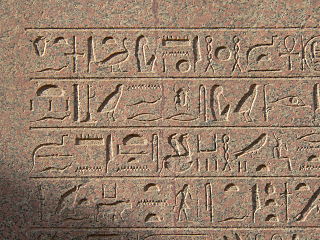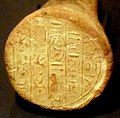
Seshat was the ancient Egyptian goddess of writing, wisdom, and knowledge. She was the daughter of Thoth. She was seen as a scribe and record keeper; her name means "female scribe". She is credited with inventing writing. She also became identified as the goddess of sciences, accounting, architecture, astronomy, astrology, building, mathematics, and surveying.

The tyet, sometimes called the knot of Isis or girdle of Isis, is an ancient Egyptian symbol that came to be connected with the goddess Isis. Its hieroglyphic depiction is catalogued as V39 in Gardiner's sign list.
The Hand drill is a hieroglyph,, used in ancient Egypt from the earliest dynasties. As a hieroglyph, it can also be used as a determinative for words related to the profession of vase, bowl, pot-making, etc., typically from fine-grained, colorful rare stone, for example unguent jars. The size of drills was small-to-large, small for small unguent jars, and large for more massive, grain-storing pottery. The original jars found in tombs were more often used for ceremonial usages, presumably the reason they are found as grave goods or tomb offerings.
The ancient Egyptian Harpoon,, is one of the oldest language hieroglyphs from ancient Egypt. It is used on the famous Narmer Palette of Pharaoh Narmer from the 31st century BC, in an archaic hieroglyphic form.

The ancient Egyptian Mast hieroglyph is one of the oldest language hieroglyphs from Ancient Egypt. It is used on a famous label of Pharaoh Den of the First dynasty, but forms part of the location hieroglyph: Emblem of the East.
The Foreleg of ox hieroglyph of ancient Egypt is a hieroglyph; it is the nighttime constellation Ursa Major called as Maskheti constellation. It came to have many uses in ancient Egypt over its entire history.
The ancient Egyptian Papyrus stem hieroglyph is one of the oldest language hieroglyphs from Ancient Egypt. The papyrus stalk, was incorporated into designs of columns on buildings, also facades, and is also in the iconographic art portrayed in ancient Egyptian decorated scenes.

Scarabs are amulets and impression seals shaped according to the eponymous beetles, which were widely popular throughout ancient Egypt. They survive in large numbers today, and through their inscriptions and typology, these artifacts prove to be an important source of information for archaeologists and historians of ancient Egypt, representing a significant body of its art.

The pectorals of ancient Egypt were a form of jewelry, often in the form of a brooch. They are often also amulets, and may be so described. They were mostly worn by richer people and the pharaoh.

The Egyptian hieroglyph representing gold, phonetic value nb, is important due to its use in the Horus-of-Gold name, one of the Fivefold Titulary names of the Egyptian pharaoh.

The ancient Egyptian Bone-with-meat hieroglyph represented: "ancestry, inherit", and phonetic isw, iw' ; a determinative for the femur, (iw'); and swt, for the tibia.

The ancient Egyptian Sky hieroglyph,, is Gardiner sign listed no. N1, within the Gardiner signs for sky, earth, and water.
The ancient Egyptian Brazier hieroglyph is Gardiner sign listed no. Q7 for the cooking brazier. It is shown from the Old Kingdom in the style of a vertical burning flame upon four feet, but the hieroglyph has the flame hiding the fourth foot. Another Gardiner unlisted form has the four feet, with no flame, and in a plan view.
The ancient Egyptian Face hieroglyph, Gardiner sign listed no. D2 is a portrayal of the human face, frontal view.

The ancient Egyptian Pick hieroglyph, Gardiner sign listed nos. U17, U18 is a portrayal of a 'pick upon the side view of a block'; it is in the Gardiner subset for agriculture, crafts, and professions.

The ancient Egyptian Two Whips with Shen ring hieroglyph, Gardiner sign listed no. S23 is a portrayal of the Shen ring with two Egyptian flails-(Crook and flail); it is a member of the Gardiner subset for "crowns, dress, staves, etc".

In the Egyptian language, the single stair hieroglyph is used as a determinative.

The heart scarab is an oval scarab artifact dating from ancient Egypt. Mostly an amulet, it was also used as jewelry, a memorializing artifact, or a grave good. The heart scarab was used by referring to Chapter 30 from the Book of the Dead and the weighing of the heart, being balanced by Maat, goddess of truth, justice, order, wisdom, and cosmic balance. The function of the heart scarab was to bind the heart to silence while it was being weighed in the underworld to ensure that the heart did not bear false witness against the deceased. As in many current religions, the individual had to show 'worthiness' to achieve the afterlife. The heart was extremely important to ancient Egyptians as the seat of intelligence and the storehouse of memory. It was the only organ left in place during mummification. Heart scarab amulets were meant as substitutes for the heart should the deceased be deprived of the organ in the afterlife. For example, when a person died, a heart scarab was often placed on their heart and bound underneath the bandages of the mummy. This was to ensure that it could not be physically removed from their person.
The ancient Egyptian Papyrus roll-tied and sealed hieroglyph comes in the common horizontal, or a vertical form. It is juxtaposed against an open scroll, the Papyrus roll-open hieroglyph,















